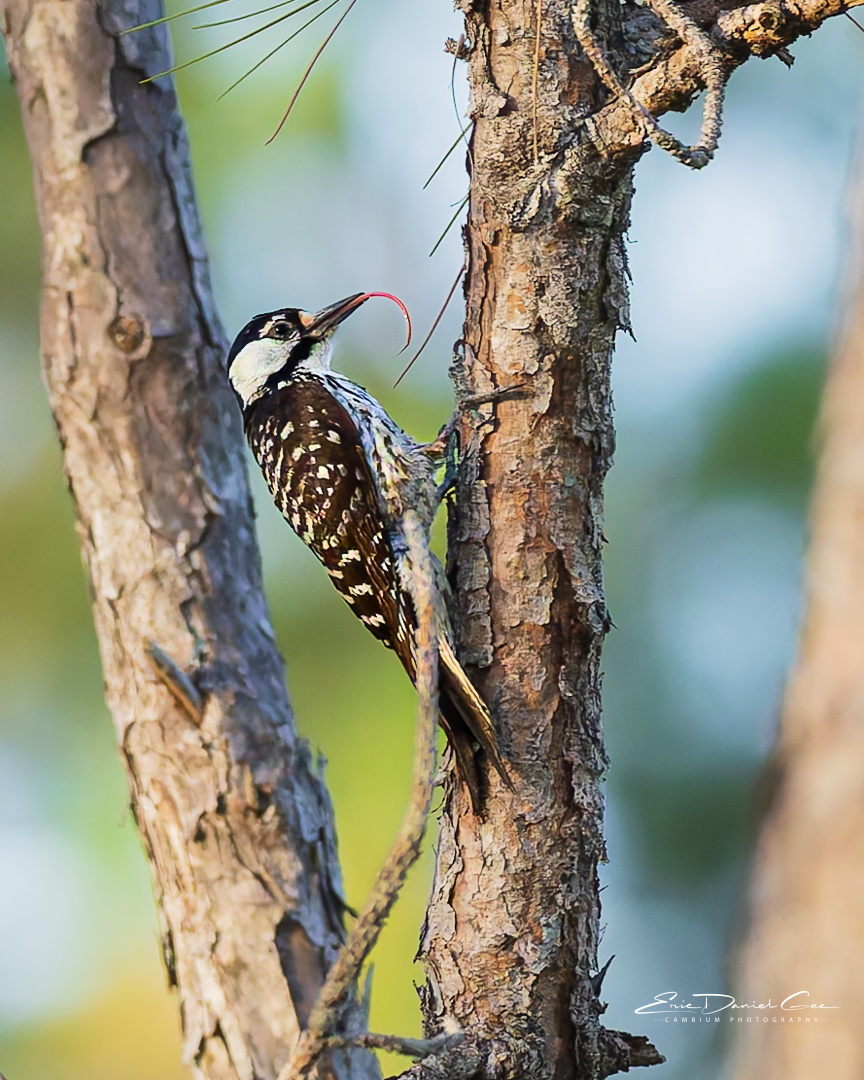PICTURE DAY SHENANNIGANS
A Rare Encounter with the Red-Cockaded Woodpecker
Just before sunset, as the golden light filtered through the tall longleaf pines (Pinus palustris) of Big Branch Marsh National Wildlife Refuge, I spotted a flicker of movement along a pine trunk. There, nearly camouflaged against the bark, was Picoides borealis—the Red-cockaded Woodpecker. Quiet and deliberate, it flitted from tree to tree, searching for insects using its powerful beak. These birds aren’t flashy or loud; in fact, they’re so subtle in their movements that you might never know they’re nearby unless you’re looking—and listening—closely.
This was my first-ever sighting of the species, a bucket-list moment for me both personally and professionally. But as if that wasn't special enough, the bird gave me a photographer’s dream: it stuck its tongue out—right at the camera. A perfectly timed moment, it felt like a child caught mid-giggle during school picture day. You can spend years photographing wildlife and never catch something this rare or this comical. It’s one of those moments you couldn’t plan if you tried—and it’s exactly what keeps me coming back.
Nat Geo Meets Middle-School Yearbook Pic
Hamming it up for the camera? Absolutely.
This Red-cockaded Woodpecker stuck its tongue out like a kid on picture day—full of personality and perfect timing.
The Red-cockaded Woodpecker is no ordinary bird. Historically found throughout the southeastern U.S., their population plummeted in the 20th century due to the loss of old-growth pine habitat. Unlike most woodpeckers that nest in dead wood, Picoides borealis carves its cavities into living pines, often those weakened by red heart fungus (Phellinus pini), which softens the heartwood. This slow excavation process—sometimes taking years—makes old, healthy pine forests essential to their survival.
In 1970, the species was officially listed as endangered under the Endangered Species Conservation Act, and its decline became a rallying point for habitat-focused conservation. Decades of hard work followed: prescribed burns to mimic natural fire regimes, midstory vegetation management, and even the installation of artificial nesting cavities to give populations a boost. Thanks to this science-driven approach, the Red-cockaded Woodpecker’s numbers have begun to rebound in several regions.
What’s truly amazing is that this comeback story isn’t unfolding in remote wilderness—it’s happening right near major urban areas. Big Branch Marsh, just across Lake Pontchartrain from metro New Orleans, is a testament to how intentional forest management and conservation planning can help threatened species thrive, even close to human development.
Standing there in the fading light, camera balanced and heart racing, I felt the weight of the moment. Not only was I photographing a bird I’d long hoped to see, but I was witnessing a living symbol of conservation success. And just to keep me humble—or maybe to make sure I smiled—it stuck its tongue out like a kid being silly during picture day.
This image is more than just a lucky shot. It’s a celebration of science, stewardship, and the resilience of a species once on the brink. It’s a moment of humor, wonder, and connection with the natural world. And it’s a reminder that with the right tools and commitment, we can preserve these wild places—and the incredible creatures that call them home—for generations to come.


